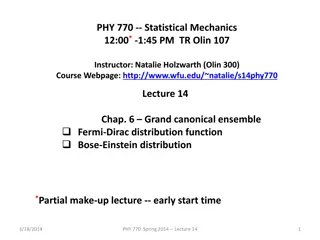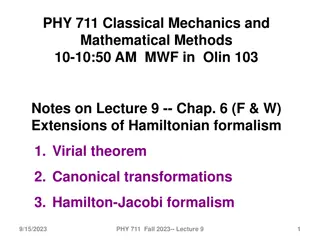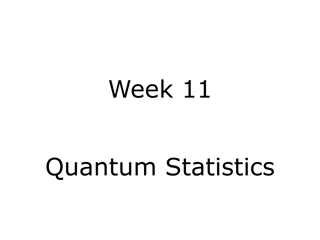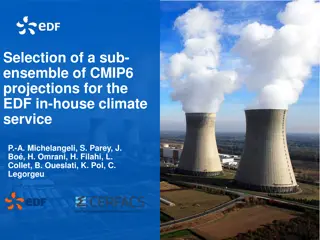
Microstructural Evolution in Materials: Canonical Ensemble Explanation
Explore how canonical ensemble maintains constant temperature and volume, leading to thermal equilibrium and energy distribution in systems. Learn the model for deriving canonical distribution and examples of macrostates and microstates. Discover the intricate balance of energy levels and configurations within the composite system.
Download Presentation

Please find below an Image/Link to download the presentation.
The content on the website is provided AS IS for your information and personal use only. It may not be sold, licensed, or shared on other websites without obtaining consent from the author. If you encounter any issues during the download, it is possible that the publisher has removed the file from their server.
You are allowed to download the files provided on this website for personal or commercial use, subject to the condition that they are used lawfully. All files are the property of their respective owners.
The content on the website is provided AS IS for your information and personal use only. It may not be sold, licensed, or shared on other websites without obtaining consent from the author.
E N D
Presentation Transcript
MIT 3.022 Microstructural Evolution in Materials 3: Canonical Ensemble Juejun (JJ) Hu hujuejun@mit.edu
This lecture will tell you why fridge works!
Canonical ensemble Boundary condition: system temperature and volume is kept constant System in thermal equilibrium with heat reservoir held at T Rigid, thermally conductive walls System energy is not fixed!
Canonical ensemble Boundary condition: system temperature and volume is kept constant Gas molecule Inelastic process Rigid, thermally conductive walls System energy is not fixed!
Model for deriving the canonical distribution A composite system consisting of N (N is large) identical systems in thermal equilibrium with each other and isolated from the surroundings For all systems: constant T = Constraints: = N N i i = = constant N E E i i tot i Effectively, each system is in equilibrium with a large heat reservoir (consisting of N 1 systems) at temperature T
Example: N = 5 Each system s energies: 0, , 2 , 3 , 4 , 5 Total energy of composite system: 5 Macrostate: energy distribution among the systems e.g. one system with 5 , four systems with 0 A B C D E 0 2 0 3 0 4 0 5 1 Energy level # of system 0 4
Example: N = 5 Each system s energies: 0, , 2 , 3 , 4 , 5 Total energy of composite system: 5 Macrostate: energy distribution among the systems e.g. one system with 5 , four systems with 0 Microstate: a specific configuration of the ensemble A B C D E 5 4 3 2 Microstate (5 0 0 0 0): 0
Example: N = 5 Each system s energies: 0, , 2 , 3 , 4 , 5 Total energy of composite system: 5 Macrostate: energy distribution among the systems e.g. one system with 5 , four systems with 0 Microstate: a specific configuration of the ensemble A B C D E 5 4 3 2 Microstate (0 5 0 0 0): 0
Example: N = 5 A B C D E Macrostate 0 2 0 3 0 4 0 5 1 Energy level # of system 0 4 Microstates: (5 0 0 0 0), (0 5 0 0 0), (0 0 5 0 0), (0 0 0 5 0), (0 0 0 0 5) Number of microstates: = 5
Example: N = 5 A B C D E Macrostate 1 2 0 3 0 4 1 5 0 Energy level # of system 0 3 Microstates: (4 1 0 0 0), (4 0 1 0 0), (4 0 0 1 0), (4 0 0 0 1), (1 4 0 0 0), (0 4 1 0 0), (0 4 0 1 0), (0 4 0 0 1), (1 0 4 0 0), (0 1 4 0 0), (0 0 4 1 0), (0 0 4 0 1), (1 0 0 4 0), (0 1 0 4 0), (0 0 1 4 0), (0 0 0 4 1), (1 0 0 0 4), (0 1 0 0 4), (0 0 1 0 4), (0 0 0 1 4) Number of microstates: = 20
Example: N = 5 A B C D E = Macrostate i N N N1 2 N2 3 N3 4 N4 5 N5 Energy level # of system 0 N0 Microstate counting First pick N0 systems out of the total of N systems and set them to 0 energy; then pick N1 systems out of the remaining N-N0 systems and set them to energy; and so on ! ! N N Number of microstates: = = ! ! ! ! ! ! ! N N N N N N N 0 1 2 3 4 5 i i
Example: N = 5 A B C D E Macrostates Macrostate [N0, N1, N2, N3, N4, N5] [4, 0, 0, 0, 0, 1] [3, 1, 0, 0, 1, 0] [2, 2, 0, 1, 0, 0] [2, 1, 2, 0, 0, 0] [3, 0, 1, 1, 0, 0] [1, 3, 1, 0, 0, 0] [0, 5, 0, 0, 0, 0] Degeneracy 5 20 30 30 20 20 1 The most probable states Equilibrium state of macroscopic systems can be identified by finding the maximum of the probability distribution function
Example: N = 5 Small N: broad distribution [131000] [050000] Macrostates [400001] [310010] [220100] [301100] [212000]
Canonical distribution Problem statement Derive the probability distribution of a system s energy at constant temperature T Approach Consider an ensemble of N systems subjecting to the constraints: = = , N N N E E i i i tot Find the most probable macrostate, i.e. = max The most probable macrostate represents the equilibrium probability distribution
Canonical distribution ! N = Probability of a macrostate ! N i Maximize with constraints: ( ) ln 0 m N i = = = , N N N E E (for all m) i i i tot Lagrange multiplier: maximize a new function containing two undetermined constants and , and assume that all Ni have no constraints. In the end, and are chosen to meet both constraints. The new function to maximize: = + ln F N N E i i i i i
Canonical distribution Assume that all Ni have no constraints ( ) ln F N N = + E m m m ( ) ln N ! N = = ln ln ! ln ! N N N N m i m ! N i i m i ( ) ln dN d N N N ln dN ! d N = = = m m m ln m N m m m F N ( ) = + = = ln 0 exp N E N E m m m m m
Canonical distribution Now apply the constraints: = N N 1) i N ( ) = = exp e E N ( ) i exp E i i Partition function i ( ) exp exp i E 1exp Z N N ( ) ( ) = = i E = i E exp Z E where ( ) i i i i 1 = = N E E 2) (see lecture notes for detailed derivation) i i tot kT 1 Z N N E kT = = Canonical distribution exp i i P i
Interpretation of partition function Z 1 The summation is over all states (not energy levels) of the system i E = = Z e kT i ( ) At low T, the system is frozen at the ground state = = + + + = 0 0 1 Z T e e e ( ) At high T, all energy levels are equally likely to be occupied = + + = 0 0 0 Z T e e e Thus, the partition function gives an indication of the number of states that are accessible to the system at a given temperature.
Properties of a canonical ensemble Ensemble average of variables: probability weighted average Average energy E kT E e 1 Z ln Z i i e = P E = = = E E E e i i i i E kT i i A general extensive variable B E kT B e 1 Z i i e = P B = = E B B e i i i i E kT i i
Effect of gravitational force on gas density Example: density of gas held at constant temperature T subjected to gravitational force 1) Identify the system We take a single gas molecule as the system 2) Determine Hamiltonian or energy levels E mgh = 3) Calculate Z and canonical distribution 1exp exp P Z kT F = mg E mgh kT = 4) Calculate system properties P Rigid, thermally conductive walls ( ) exp mgh kT Density
Paramagnetism and the Curies Law Consider one atom with a magnetic dipole: Two states (+): Probability (+): Average magnetic dipole: += + + ( = E p H , (-): H kT E H p ( ) , (-): ) + H kT exp exp ( ) ( ) ( ( ) ) ( ( ) ) + + exp exp exp exp P P P H kT H kT H kT H kT H + = = = tanh H + P kT + 2H kT ( ) M H kT = ( ) H kT 2 1 T n H H = M Curie s law k
Summary Identify the system Determine the system energy Ei at state i Probability distribution: = 1 Z E kT E kT exp exp i i P i Partition function (summing over all system states i): ( ) exp i i i iE kT = = Z E e Ensemble average of variables: 1 i i i Z iE kT ln Z = P E = = E E e i
Microcanonical distribution We use ito label a system s microscopic state Problem: when the system is held at constant energy E, what is the probability Pi of finding the system at a particular microscopic state i? 1 Total # of accessible microscopic states iP =
Making sense of canonical distribution We use ito label a system s microscopic state Problem: when the system is held at temperature T, what is the probability Pi of finding the system at a particular microscopic state i? If we make N (N is large) macroscopically identical copies of the system, then the number of copies Ni residing at the microscopic state i is: = N P N i i We use the following relation to derive Pi: N P N = i i
Making sense of canonical distribution Our story begins with a large family of macroscopically identical systems (the canonical ensemble) I JJ E K D The systems are all macroscopically identical but are distinguishable C B We all look alike but have unique names! System A
Making sense of canonical distribution All systems happily share energy among them, but are isolated from the rest of the world Walls (nothing can get through) When alone I am canonical ; but when a LARGE group of us are packed together we become MICROcanonical the name doesn t quite make sense, huh?
Making sense of canonical distribution Some systems get a bit more energy than others. We call the energy distribution a macrostate. E Number of systems at microscopic state i Ni = 1 Ei Ni-1 = 2 Ei-1 Macrostates do NOT assign energy values to specific systems; only the overall distribution of system over energy levels N1 = 2 E1 We are NOT calling out any names yet! N0 = 4 E0
Making sense of canonical distribution This is a microstate Each system is assigned to an energy level by name D E Ni = 1 Ei H Ni-1 = 2 A Ei-1 B N1 = 2 E E1 N0 = 4 E0 C JJ F G
Making sense of canonical distribution The ensemble prefers some macrostates more than others: the most likely one represents the equilibrium distribution E max Ni = 1 Ei Ni-1 = 2 We live happily ever after once this condition is met Ei-1 N1 = 2 E1 Thermal equilibrium is the statistically most likely state. N0 = 4 E0
Making sense of canonical distribution Now here comes the math Joseph-Louis Lagrange (1736-1813) max Then a miracle occurs And this guy s name appears somewhere 1exp Z N N E kT = = i i P i
Making sense of canonical distribution Why higher energy states are less likely? 1exp Z E kT = i P i The other systems are now left with much less energy to spare and hence fewer microstates to access! This system with high energy takes away energy from other systems in the ensemble
List of symbols T temperature k Boltzmann constant (1.38 10-23m2kg s-2K-1) Number of microscopic states / microstates Ei energy of the i-th energy level Ni number of systems at the i-th energy level Etot total energy of all (sub-) systems combined, i.e. energy of the composite system some unit energy N Total number of (sub-)systems in the composite system
List of symbols defined as = 1/kT N defined by: = e ( ) exp E i i Z (canonical) partition function Pi probability of a system residing at energy level i average energy of systems in an ensemble m mass of a gas molecule g gravitational acceleration h height magnetic dipole moment E
List of symbols H average magnetic dipole moment of an atom in a magnetic field n total number of magnetic dipoles in the material H magnetic field






















